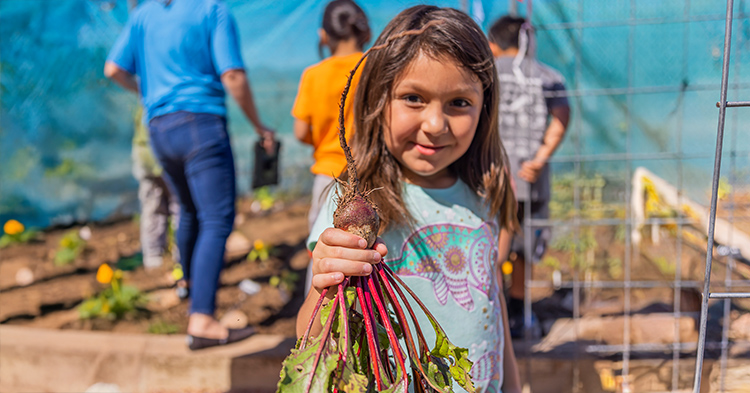A group of eager preschoolers gather around garden beds on a sunny day, their hands busy harvesting the fruits of their labor. Their class garden is bursting with color and produce, showcasing the results of their hard work. For Michael Brown and the teachers in his program, this harvest is more than just a fun morning activity–it’s a way to bring the community together, share healthy foods and connect children with the Yavapai/Apache culture of gardening.
Brown is the principal of H’man Shawa Elementary School, home of H’man Shawa Early Childhood Development Center, a Quality First participating program in the First Things First (FTF) East Maricopa region. First Things First created Quality First to help early care and education programs across Arizona improve the quality of their programs.
We recently caught up with Brown to learn more about how his program has created and nurtures a garden at the center and how gardening impacts the children, their families and the wider community.
Tell us about your program’s gardening practices.
“Twice a year we prep the grounds and beds for planting. The children plant seeds during planting seasons. Throughout the year, children and staff spend time in the garden daily either watering, cleaning or harvesting. Every Wednesday we have volunteers work in the garden. They help with weeding, planting, maintenance and harvesting.
In preparation for harvest, families share recipes for foods produced from the garden. Once we harvest, items from the garden are used during classroom cooking lessons. The harvested items are used by the cafeteria staff in meals that are served to the children. Abundant items are shared with the families and community.”
What made you start the practice of gardening?
“There were a number of reasons we wanted to create a garden in our center.
- Promote nutrition and health: We started the garden because we wanted to incorporate healthy eating into our program. We wanted to become a garden-to-table center.
- Increase family involvement: We wanted the families to participate in the school garden. We also wanted to provide the children and families information about healthy eating and healthy lifestyles.
- Incorporate Native planting: We wanted the garden to reflect Native planting by incorporating fruits and vegetables that are indigenous to the Yavapai/Apache people.
- Strengthen community connections: Another big reason is that we wanted to increase community involvement. We sensed that a school garden would help to increase participation.”
Where did you get the idea and what resources did you use?
“We got the idea from the Fountain Hills Community Garden. We saw how successful their garden was and wanted to experience that success for ourselves. The Tribal Farm was a tremendous help In the initial stages. They built garden boxes, dug trenches to run water lines, built shade structures, planted and harvested fruits and vegetables, and provided staff to maintain it daily.
After the initial stages, the Fountain Hills Community Garden volunteers have been amazing. They have provided 4-6 people every Wednesday for the last three years. They have master gardeners who teach the children and staff about all areas of gardening. The Nation’s Healthy Futures program has provided funding for all aspects of the garden. The Fort McDowell Fire Department has assisted on many occasions, helping with the maintenance of the garden.”
Can you tell us about the cultural significance of these practices?
“These practices connect various generations through the garden. We have a community member who works in the garden weekly. He educates the youth about the Yavapai/Apache culture of gardening. The practice of gardening shows respect to the Tribal members by taking care of the land. Additionally, families within the community benefit from the fruits and vegetables from the garden.”
How is this practice improving the quality of your program and what have others noticed?
“Gardening has improved the quality of foods that we are serving our children. Now, children are showing interest in eating new and healthy foods they have planted. It has improved the community involvement aspect of our program, as we share healthy foods with families and the community. It has greatly improved our relationship with the neighboring community of Fountain Hills. They recognize our garden as a place for community members to be involved by volunteering.
The garden also provides calming areas for the children. We take children through the garden daily. Parents have taken notice of this practice as well.
Having an active garden has also improved the science aspect of our program as the teachers teach lessons about composting, what nutrients the soil offers, and explore the benefits of insects that the garden houses.”
What might you tell a colleague if they were interested in incorporating similar ideas?
“I would encourage them to start a garden. The benefits are tremendous. I would also advise them to have patience, especially in the beginning phases. It’s important to seek out volunteers to assist with the garden. Volunteers help to make the process much easier.”
This gardening initiative at H’man Shawa Early Childhood Development Center is a shining example of how schools can integrate health, culture and community into early childhood education. We’d like to extend a heartfelt thank you to Michael Brown for sharing his insights and for leading such a meaningful program that continues to impact children, their families and their community.
We’d love to hear from you!
Share your tips or experiences with gardening in the comments below. Your ideas can help others succeed.

I enjoyed reading about the garden. The daily involvement of staff and children, the volunteers and community are such welcome advantages. Finally the nutrition aspect is a blessing to the children. Yeah for all who were involved in this project!